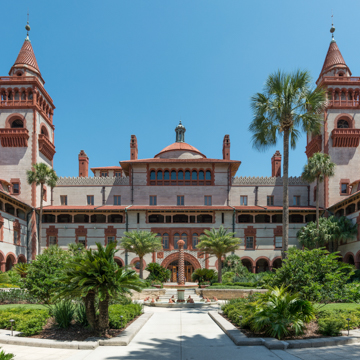You are here
Flagler College
The Ponce de Leon Hotel was the first of a string of grand hotels to be built in Florida by steel and railroad magnate Henry Flagler. The challenge for Flagler was to create a building that contained new, modern excitements and the exoticism required of the traveling American elites, who were primarily Northerners, while referencing an American and Spanish history within the complex city of St. Augustine, the oldest in the United States. St. Augustine’s origins dated back to 1565, some fifty years after the arrival in 1513 of Ponce de Leon, considered the earliest Spanish explorer in Florida. After the Civil War, St. Augustine became known as a small seaside health resort with beneficial weather and a few historical attractions, but still considered reticent to make change by the standards set in the north.
To establish the baseline of luxury expected by his guests, Flagler turned to a young architectural partnership of John Carrère (27 years old) and Thomas Hastings (25 years old), both of whom had trained at the Ecole des Beaux-Arts in Paris and worked for the established firm of upper-class luxury, McKim, Mead and White. Together with Flagler, Carrère and Hastings developed one of the first large, steel-reinforced, cast-in-place concrete buildings in the United States. The 26-year old Bernard Maybeck, who had also studied in Paris and worked with Carrère and Hastings before moving to San Francisco shortly after the project’s completion, developed the elaborate Spanish Colonial Revival style of architecture, replete with details related to the medieval, Renaissance, and Arts and Crafts periods.
One of the most significant features of the hotel was its floor plan, which was centralized around a grand courtyard and fountain and tied together through a series of walkways and covered loggias, the most prominent of which formed the building entrance on King Street. The transformative public interior experiences designed by Louis Comfort Tiffany, which included elaborate murals by George W. Maynard and the expressive paintings by Virgilio Tojetti, included references to classical antiquity, Spain, and new directions in art and design, all of which were intended to impress the worldly guests. The hotel was one of the first in the nation to be fully electrified, powered by the Edison Electric Company. Nonetheless, the hotel struggled to keep up with the technology of the period: designed with only public facilities, the hotel soon needed to be retrofitted with bathrooms in each guest room.
As Flagler extended his railroad south along the east coast of Florida to Key West, and built or purchased and updated hotels along the way, his flock of elite visitors went south with him. Although Palm Beach became the “Newport of the South” (instead of St. Augustine, as Flagler had dreamed), the Ponce de Leon Hotel always held a special place in Flagler’s heart. In 1913, Flagler died in Palm Beach but he had requested that his body be laid out in the Rotunda of the Ponce de Leon Hotel and that he be buried in St. Augustine, the town he considered home.
Although the hotel experienced a lull in tourism during the first few decades of the twentieth century, it survived the Great Depression. During World War II, the federal government took over the hotel and used it as a Coast Guard training facility. The building was returned to service as a hotel following the war. In 1964, the hotel was the site of a civil rights demonstration. Due to declining visitor numbers, the Ponce de Leon Hotel permanently closed in 1967. The following year, the newly established Flagler College purchased the hotel as the centerpiece of its new campus. For the building’s centennial in 1988, Flagler College launched a capital campaign to restore the structure.
References
Braden, Susan. The Architecture of Leisure: The Florida Resort Hotels of Henry Flagler and Henry Plant. Gainesville: University Press of Florida, 2002.
Graham, Thomas. “Flagler’s Magnificent Hotel Ponce de Leon.” The Florida Historical Quarterly54, n. 1 (July 1975): 1–17.
Graham, Thomas. Mr. Flagler’s St. Augustine.Gainesville: University Press of Florida, 2014.
Hillyer, Reiko. “The New South in the Ancient City: Flagler’s St. Augustine Hotels and Sectional Reconciliation.” The Journal of Decorative and Propaganda Arts25 (2005): 104–135.
Keys, Leslee F. Hotel Ponce de Leon: The Rise, Fall, and Rebirth of Flagler’s Gilded Age Palace.Gainesville: University Press of Florida, 2015.
Writing Credits
If SAH Archipedia has been useful to you, please consider supporting it.
SAH Archipedia tells the story of the United States through its buildings, landscapes, and cities. This freely available resource empowers the public with authoritative knowledge that deepens their understanding and appreciation of the built environment. But the Society of Architectural Historians, which created SAH Archipedia with University of Virginia Press, needs your support to maintain the high-caliber research, writing, photography, cartography, editing, design, and programming that make SAH Archipedia a trusted online resource available to all who value the history of place, heritage tourism, and learning.

